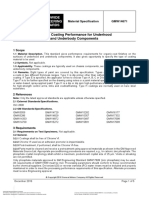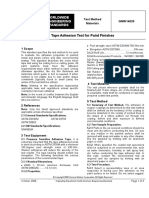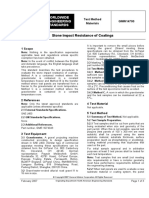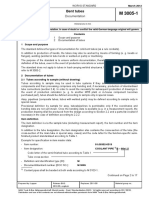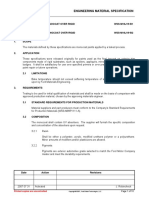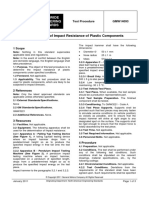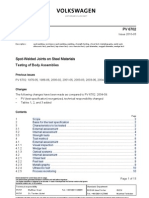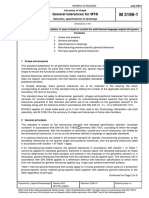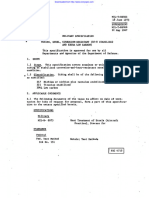Worldwide Engineering Standards: Tape Adhesion Test For Paint Finishes
Worldwide Engineering Standards: Tape Adhesion Test For Paint Finishes
Uploaded by
Akmal NizametdinovCopyright:
Available Formats
Worldwide Engineering Standards: Tape Adhesion Test For Paint Finishes
Worldwide Engineering Standards: Tape Adhesion Test For Paint Finishes
Uploaded by
Akmal NizametdinovOriginal Title
Copyright
Available Formats
Share this document
Did you find this document useful?
Is this content inappropriate?
Copyright:
Available Formats
Worldwide Engineering Standards: Tape Adhesion Test For Paint Finishes
Worldwide Engineering Standards: Tape Adhesion Test For Paint Finishes
Uploaded by
Akmal NizametdinovCopyright:
Available Formats
WORLDWIDE
ENGINEERING Test Procedure GMW14829
STANDARDS
Tape Adhesion Test for Paint Finishes
1 Scope
Note: Nothing in this standard supercedes applicable laws and regulations.
Note: In the event of conflict between the English and domestic language, the English language shall take
precedence.
1.1 Purpose. This standard specifies the test method to be used to evaluate the adhesion properties of
painted metal, plastic and sealer before and after environmental testing. This standard describes the
crosshatch and the “X” cut tape adhesion test using the cutting tools or cutting guide. All paint systems must
meet the adhesion requirements when the appropriate method is used. Unless otherwise specified, the dry film
thickness will determine which guide or tool is required. If either method is not usable due to size and/or shape
constraints (typically found in small parts) the application of this test will be at the discretion of the responsible
engineer.
1.2 Foreword. Not applicable.
1.3 Applicability. Evaluation of the adhesion properties of painted metal, plastic and sealer before and after
environmental testing.
2 References
Note: Only the latest approved standards are applicable unless otherwise specified.
2.1 External Standards/Specifications.
ASTM D3330M ASTM D3759M
ASTM D3652M
2.2 GM Standards/Specifications.
None
3 Resources
3.1 Facilities. Not applicable.
3.2 Equipment.
3.2.1 Pressure Sensitive Adhesion Tape. It is extremely important that the tape adhesively bonds to steel --```````,```````,,```,-`-``,```,,,`---
according to ASTM D3330M with a minimum 180 degree peel strength value of 760 N/m. Weaker adhesives
will reduce the severity of the test results. The tape backing should exhibit low elongation. The various
parameters of the recommended tape are described in 3.2.1.1 thru 3.2.1.4.
3.2.1.1 Nominal Dimensions.
Width, 20 mm minimum
Thickness, total ASTM D3652M, > 0.14 mm
3.2.1.2 Properties.
Peel strength, steel ASTM D3330M, 760 N/m minimum
Elongation ASTM D3759M, 5% maximum
3.2.1.3 Shelf Life.
Twelve (12) months maximum.
© Copyright 2012 General Motors Company All Rights Reserved
October 2012 Originating Department: North American Engineering Standards Page 1 of 9
Copyright General Motors Company Order Number: 02088910
Provided by IHS under license with General Motors Company Sold to:KTL [700166100749] - CHOEY@KTL.RE.KR,
No reproduction or networking permitted without license from IHS Not for Resale,2016-01-18 02:55:26 UTC
GM WORLDWIDE ENGINEERING STANDARDS GMW14829
3.2.1.4 Recommended Products.
3M8981
3M898
Or equivalent
3.2.2 Sharp razor knife, retractable carbide cutter by Reider (Swiss) Rico Marker, cutting tool by Gardco or
BYK Gardner crosscut tester.
3.2.3 Cutting guide at 1 mm, 2 mm and 3 mm.
3.2.4 Rubber eraser or equivalent instrument for applying tape.
3.2.5 Stiff pencil brush.
3.3 Test Vehicle/Test Piece.
3.3.1 Test Material. The test pieces wherever possible shall be the finished part. If size, shape, etc., of the
finished part is impracticable, tests shall be conducted on specially prepared coated test panels.
3.4 Test Time. Not applicable.
3.5 Test Required Information. Not applicable.
3.6 Personnel/Skills. Not applicable.
4 Procedure
4.1 Preparation. The adhesion of organic coatings as determined by this test method shall be defined as the
tendency of the coating to become detached in the vicinity of scribed lines. Method A will be scribed in the
shape of a lattice pattern and Method B will be scribed in an “X” pattern. Both methods require cutting through
the coating, before and after exposure to defined environmental conditions. Use sharp blades, as dull blades
tend to cause chatter and can result in lower ratings.
4.2 Conditions. Parts in the as received conditions should be clean and dry before conducting the test. Oil,
wax or any residue in the painted surface shall be removed with soap and water or any other cleaner. Dry the
samples by blotting with an absorbent paper or cloth.
4.2.1 Environmental Conditions.
4.2.1.1 When specified, the coated test specimens shall be subjected to an environmental test, such as water
immersion, humidity or salt spray test, etc., before conducting the tape adhesion test. In this case, conduct the
environmental test as required and dry samples by blotting with an absorbent paper or cloth.
4.2.1.2 Select a representative area or an area suspected of having poor film adhesion on the paint surface to
be tested. Do not select sagged, solvent popped or obviously defective areas, as these defects should be
rated separately.
4.2.1.3 The recovery time after exposure to environmental cycle tests and before tape adhesion tests shall be
1 h unless otherwise specified.
4.2.1.4 Multiple tape adhesion tests may be required (minimum of three) depending on approval requirements
and space permitting. Larger parts will require more space. Geometric configuration and processing
characteristics should be considered.
4.2.2 Test Conditions. Deviations from the requirements of this standard shall have been agreed upon. Such
requirements shall be specified on component drawings, test certificates, reports, etc.
4.3 Instructions.
4.3.1 Test Procedure, Method A.
4.3.1.1 The crosshatch/cutting tool should be inspected prior to use and replaced if any damage is observed.
The crosshatch/cutting tool should be replaced if any inconsistencies in the scribe installation are observed.
4.3.1.2 Make a crosshatch cut with a sharp cutting tool or guide as shown in Figure A1. The number of lines
and spacing between the lines shall depend upon the coating film thickness as shown in Table A1. Make all
cuts approximately 20 mm long. Cut through the film in one steady motion using just sufficient pressure on the
cutting tool to have the cutting edge reach the substrate. When making successive single cuts with the aid of a
guide, place the guide on the uncut area and cut through the film to the substrate. Make similar type and
number of cuts perpendicular and centered on the original cuts.
© Copyright 2012 General Motors Company All Rights Reserved
October 2012 Page 2 of 9
--```````,```````,,```,-`-``,```,,,`---
Copyright General Motors Company Order Number: 02088910
Provided by IHS under license with General Motors Company Sold to:KTL [700166100749] - CHOEY@KTL.RE.KR,
No reproduction or networking permitted without license from IHS Not for Resale,2016-01-18 02:55:26 UTC
GM WORLDWIDE ENGINEERING STANDARDS GMW14829
4.3.1.3 After making the required cuts, brush the film lightly with a soft bristle brush or tissue to remove any
detached flakes or ribbons of coating.
4.3.1.4 Dispense or cut a strip of tape approximately 75 mm long being careful not to allow the adhesive side
to come in contact with anything before the test application. Place the center of the tape over the grid so that
the tape covers the crosshatch diagonally.
4.3.1.5 Press the tape down firmly on the surface with sufficient rubs of the eraser to remove air bubbles and
to insure good contact between the tape and paint surface.
4.3.1.6 After 5 s to 10 s, grasp the tail end of the tape between thumb and forefinger and pull upward with a
rapid jerking motion perpendicular to the paint film.
4.3.1.7 Rate the adhesion performance as shown in Figure A2, and description of performance using the key
in Table A2. Paint adhesion should be reviewed on both the part and the tape.
4.3.2 Test Procedure, Method B.
4.3.2.1 The scribe/cutting tool should be inspected prior to use and replaced if any damage is observed. The
scribe/cutting tool should be replaced if any inconsistencies in the scribe installation are observed.
4.3.2.2 With a sharp pointed razor knife, cut an “X” consisting of two bisecting lines each approximately 75 mm
long, through the paint film to the substrate as shown in Figure A3. If the area to be tested on the painted
sample is less than the standard tape test area, then the application of this test will be at the discretion of the
responsible engineer. If utilized, report the percentage area remaining on the surface as shown in Figure A4.
When cutting, hold knife perpendicular to the surface and avoid any side motion. For relatively soft substrates,
such as plastics and sealers, avoid cutting so deeply that the substrate is displaced.
4.3.2.3 After making the required cuts, brush the film lightly with a soft bristle brush or tissue to remove any
detached flakes or ribbons of coating.
4.3.2.4 Dispense or cut a strip of tape approximately 125 mm to 150 mm long being careful not to allow the
adhesive side to come in contact with anything before the test application.
4.3.2.5 Cover the “X” with tape so that the tape is centered over the intersection and extends for at least
38 mm on both sides of the intersection in the direction of approximately the 25 degree angles. The remaining
50 mm to 75 mm of tape provides a loose tail on one end to grasp when removing tape.
4.3.2.6 Press the tape down firmly on the surface with sufficient rubs of the eraser to remove air bubbles and
to insure good contact between the tape and paint surface.
4.3.2.7 After 5 s to 10 s, grasp the tail end of the tape between thumb and forefinger and pull upward with a
rapid jerking motion perpendicular to the paint film.
4.3.2.8 Estimate the percentage area of paint not removed by the tape test area of 20 mm x 75 mm
(1500 mm2) as shown in Figure A5. Paint adhesion should be reviewed on both the part and the tape.
5 Data
5.1 Calculations. Not applicable.
5.2 Interpretation of Results. Not applicable.
5.3 Test Documentation.
5.3.1 Report: Method A. Record the tape adhesion rating as shown in Figure A2.
5.3.1.1 Record the failure mode indicating where the failure occurred, that is, within substrate, between first
coat and substrate, between first and second coat, etc.
5.3.1.2 Submit both painted sample and tape for review. Tape should be submitted on an overhead (acetate
film). The tape should never be placed back on the sample.
5.3.2 Report: Method B. Record the tape adhesion rating as the percentage of area of paint remaining as
shown in Figure A5, and the type of removal as shown in Figure A6.
5.3.2.1 Record the failure mode indicating where the failure occurred, that is, within substrate, between first
coat and substrate, between first and second coat, etc.
5.3.2.2 Submit both painted sample and tape for review. Tape should be submitted on an overhead (acetate
film). The tape should never be placed back on the sample.
© Copyright 2012 General Motors Company All Rights Reserved
October 2012 Page 3 of 9
--```````,```````,,```,-`-``,```,,,`---
Copyright General Motors Company Order Number: 02088910
Provided by IHS under license with General Motors Company Sold to:KTL [700166100749] - CHOEY@KTL.RE.KR,
No reproduction or networking permitted without license from IHS Not for Resale,2016-01-18 02:55:26 UTC
GM WORLDWIDE ENGINEERING STANDARDS GMW14829
6 Safety
This standard may involve hazardous materials, operations, and equipment. This standard does not propose to
address all the safety problems associated with its use. It is the responsibility of the user of this standard to
establish appropriate safety and health practices and determine the applicability of regulatory limitations prior
to use.
7 Notes
7.1 Glossary. Not applicable.
7.2 Acronyms, Abbreviations, and Symbols. Not applicable.
8 Coding System
This standard shall be referenced in other documents, drawings, etc., as follows:
--```````,```````,,```,-`-``,```,,,`---
Test to GMW14829
9 Release and Revisions
This standard was originated in November 2005. It was first approved by Paint in September 2006. It was first
published in October 2006.
Issue Publication Date Description (Organization)
1 OCT 2006 Initial publication.
2 JAN 2011 Removed regional standard references and made minimal changes to
content. (Global Paint and Polymers Center).
3 OCT 2012 Added a new 4.3.1.1 and 4.3.2.1 and renumbered existing paragraphs
(obtained email approval from Global Paint and Polymers Center for
changes and to publish and approve document through Global
Corrosion GSSLT). (Corrosion GSSLT)
© Copyright 2012 General Motors Company All Rights Reserved
October 2012 Page 4 of 9
Copyright General Motors Company Order Number: 02088910
Provided by IHS under license with General Motors Company Sold to:KTL [700166100749] - CHOEY@KTL.RE.KR,
No reproduction or networking permitted without license from IHS Not for Resale,2016-01-18 02:55:26 UTC
GM WORLDWIDE ENGINEERING STANDARDS GMW14829
Appendix A
--```````,```````,,```,-`-``,```,,,`---
Figure A1: Crosshatch Test (Method A)
Table A1: Cutter Spacing for Test Method A
Film Thickness Spacing Number of Cuts
(microns) (millimeters) (In each direction)
60 1 6
60 to 200 2 6
200 3 6
© Copyright 2012 General Motors Company All Rights Reserved
October 2012 Page 5 of 9
Copyright General Motors Company Order Number: 02088910
Provided by IHS under license with General Motors Company Sold to:KTL [700166100749] - CHOEY@KTL.RE.KR,
No reproduction or networking permitted without license from IHS Not for Resale,2016-01-18 02:55:26 UTC
GM WORLDWIDE ENGINEERING STANDARDS GMW14829
Surface of crosscut
Greater
area from which None than
flaking has occurred
65%
Rating
(classification) 3 5
0 1 2 4
Figure A2: Adhesion Performance for Test Method A (Crosshatch)
Table A2: Rating Scale Key for Test Method A (Crosshatch)
Rating Description
The edges of the cuts are completely smooth; none of the squares of the lattice is
0
detached.
Detachment of small flakes of the coating at the intersections of the cuts.
1
Across cut area of 5% maximum is affected.
The coating has flaked along the edges and/or at the intersections of the cuts.
2
Across cut area of 5% minimum but 15% maximum.
The coating has flaked along the edges of the cuts partly or wholly in large ribbons,
3 and/or it has flaked partly or wholly on different parts of the squares.
Across cut area of 15% minimum but 35% maximum is affected.
The coating has flaked along the degrees of the cuts in large ribbons and/or some
4 squares have detached partly or wholly.
Across cut area of 35% minimum but 65% maximum is affected.
5 A crosscut area of > 65% is affected
© Copyright 2012 General Motors Company All Rights Reserved
October 2012 Page 6 of 9
--```````,```````,,```,-`-``,```,,,`---
Copyright General Motors Company Order Number: 02088910
Provided by IHS under license with General Motors Company Sold to:KTL [700166100749] - CHOEY@KTL.RE.KR,
No reproduction or networking permitted without license from IHS Not for Resale,2016-01-18 02:55:26 UTC
GM WORLDWIDE ENGINEERING STANDARDS GMW14829
Figure A3: X-Cut Test (Method B)
Figure A4: X-Cut Test Small Area (Method B)
© Copyright 2012 General Motors Company All Rights Reserved
October 2012 Page 7 of 9
--```````,```````,,```,-`-``,```,,,`---
Copyright General Motors Company Order Number: 02088910
Provided by IHS under license with General Motors Company Sold to:KTL [700166100749] - CHOEY@KTL.RE.KR,
No reproduction or networking permitted without license from IHS Not for Resale,2016-01-18 02:55:26 UTC
GM WORLDWIDE ENGINEERING STANDARDS GMW14829
Figure A5: Adhesion Performance for Test Method B (X-Cut)
© Copyright 2012 General Motors Company All Rights Reserved
October 2012 Page 8 of 9
--```````,```````,,```,-`-``,```,,,`---
Copyright General Motors Company Order Number: 02088910
Provided by IHS under license with General Motors Company Sold to:KTL [700166100749] - CHOEY@KTL.RE.KR,
No reproduction or networking permitted without license from IHS Not for Resale,2016-01-18 02:55:26 UTC
GM WORLDWIDE ENGINEERING STANDARDS GMW14829
A - Paint removed along knife cut evenly
B - Paint removed in the “V” section of the knife cut
C - Paint removed in a “Patch not Touching” knife cut
D - Paint Removed in a “Patch Touching” knife cut
Figure A6: Type of Removal
© Copyright 2012 General Motors Company All Rights Reserved
October 2012 Page 9 of 9
--```````,```````,,```,-`-``,```,,,`---
Copyright General Motors Company Order Number: 02088910
Provided by IHS under license with General Motors Company Sold to:KTL [700166100749] - CHOEY@KTL.RE.KR,
No reproduction or networking permitted without license from IHS Not for Resale,2016-01-18 02:55:26 UTC
You might also like
- Medicinal Chmistry TextbookDocument618 pagesMedicinal Chmistry TextbookJin Chonden100% (4)
- Test Method of Flammability of Interior Materials For AutomobilesDocument17 pagesTest Method of Flammability of Interior Materials For AutomobilesKarthic BhrabuNo ratings yet
- PV 3935 enDocument13 pagesPV 3935 enpatborNo ratings yet
- GMW14671 (Dec 2016)Document5 pagesGMW14671 (Dec 2016)Ashley Wiley100% (2)
- Gravimetric Determination of Condensable Components: Group StandardDocument6 pagesGravimetric Determination of Condensable Components: Group Standardthiagomcasimiro100% (1)
- GMW14400 May2007 PDFDocument9 pagesGMW14400 May2007 PDFAkmal NizametdinovNo ratings yet
- Worldwide Engineering Standards: Vehicle BallastDocument20 pagesWorldwide Engineering Standards: Vehicle BallastAkmal NizametdinovNo ratings yet
- GMW 14829 PDFDocument3 pagesGMW 14829 PDFEd Ri100% (2)
- Worldwide Engineering Standards: Stone Impact Resistance of CoatingsDocument6 pagesWorldwide Engineering Standards: Stone Impact Resistance of CoatingsAlondra CVNo ratings yet
- GMW 14124 汽车环境循环测试 PDFDocument7 pagesGMW 14124 汽车环境循环测试 PDFlrobertothNo ratings yet
- Testing Methods of Chemical Resistance For Plastic Parts: Nissan Engineering StandardDocument13 pagesTesting Methods of Chemical Resistance For Plastic Parts: Nissan Engineering StandardDiego Camargo100% (2)
- Worldwide Engineering Standards: Corrosion Performance SpecificationDocument8 pagesWorldwide Engineering Standards: Corrosion Performance SpecificationAkmal Nizametdinov100% (1)
- General Tolerances For MN: MAN Nutzfahrzeuge AG Works Standard Accuracy of ShapeDocument3 pagesGeneral Tolerances For MN: MAN Nutzfahrzeuge AG Works Standard Accuracy of ShapeAkmal Nizametdinov100% (1)
- Gantry CraneDocument6 pagesGantry CraneAdrianmb0% (1)
- Test Method: Renault Automobiles Standardisation DPMI / Service 67250 Section Normes Et Cahiers Des ChargesDocument13 pagesTest Method: Renault Automobiles Standardisation DPMI / Service 67250 Section Normes Et Cahiers Des ChargesJose ValenciaNo ratings yet
- GMW14698 ArranhõesDocument7 pagesGMW14698 ArranhõesRicardo F. SNo ratings yet
- PV 3942Document15 pagesPV 3942Chloe ReyesNo ratings yet
- Worldwide Engineering Standards: Stone Impact Resistance of CoatingsDocument3 pagesWorldwide Engineering Standards: Stone Impact Resistance of CoatingsAnvarbek KarimovNo ratings yet
- EX-GM-006 - GMW 14698 - 200709 - EN - Scratch Resistance of Orangnic Coatings and Self-Adhesion Foils PDFDocument3 pagesEX-GM-006 - GMW 14698 - 200709 - EN - Scratch Resistance of Orangnic Coatings and Self-Adhesion Foils PDFEd RiNo ratings yet
- GMW 15645 (2008)Document5 pagesGMW 15645 (2008)MayllaNo ratings yet
- PV 3906 enDocument3 pagesPV 3906 enMarcelo Luiz PereiraNo ratings yet
- D271327 C' PDFDocument5 pagesD271327 C' PDFReza AbdolahiNo ratings yet
- Worldwide Engineering Standards: Procedures For High Humidity TestDocument3 pagesWorldwide Engineering Standards: Procedures For High Humidity TestAkmal NizametdinovNo ratings yet
- PV 3952 (2002)Document4 pagesPV 3952 (2002)Matthew Taylor100% (2)
- Worldwide Engineering Standards: Procedures For High Humidity TestDocument3 pagesWorldwide Engineering Standards: Procedures For High Humidity TestAkmal NizametdinovNo ratings yet
- Worldwide Engineering Standards: Material Specification Finish GMW14664Document8 pagesWorldwide Engineering Standards: Material Specification Finish GMW14664Akmal Nizametdinov100% (1)
- Material Specification Finish GMW14669: Publication Department: GME Specification CenterDocument9 pagesMaterial Specification Finish GMW14669: Publication Department: GME Specification CenterRoman Valerio Ibarra100% (2)
- Coating Systems For The Series Version of Standard Trucks As Well As For Bus Components and AttachmentsDocument24 pagesCoating Systems For The Series Version of Standard Trucks As Well As For Bus Components and AttachmentsAkmal NizametdinovNo ratings yet
- Bent Tubes: DocumentationDocument17 pagesBent Tubes: DocumentationAkmal NizametdinovNo ratings yet
- GMW3220 Aug 2016Document4 pagesGMW3220 Aug 2016Elena Ruiz100% (1)
- GMW 14670 - May 2007 - Organic Coat For Finish WheelsDocument4 pagesGMW 14670 - May 2007 - Organic Coat For Finish WheelsatulmkaushalNo ratings yet
- Organic Coat GMW 14670 PDFDocument4 pagesOrganic Coat GMW 14670 PDFYosua Dimas Agus SriyantoNo ratings yet
- Worldwide Engineering Standards: Tape Adhesion Test For Paint FinishesDocument3 pagesWorldwide Engineering Standards: Tape Adhesion Test For Paint FinishesRicardo Bavasso100% (1)
- WSS M16J19 BDocument10 pagesWSS M16J19 BJuan Angel DechimaNo ratings yet
- WSS M8P16 BDocument16 pagesWSS M8P16 Berik0007No ratings yet
- GMW14381Document5 pagesGMW14381Akmal NizametdinovNo ratings yet
- Test of Ozone Resistance and Plastic Deformation: Group StandardDocument4 pagesTest of Ozone Resistance and Plastic Deformation: Group Standardali soydaşNo ratings yet
- Performance Requirements For Engine Compartment Plastic PartsDocument5 pagesPerformance Requirements For Engine Compartment Plastic PartsAkmal Nizametdinov100% (1)
- PV 1303 enDocument8 pagesPV 1303 enpriscilaNo ratings yet
- TMS6900Document14 pagesTMS6900Josue Garcia QuiniNo ratings yet
- Psa D 271571 2003Document9 pagesPsa D 271571 2003KasraNo ratings yet
- Resistance To Fuels of Exteriors Automotive Materials and ComponentsDocument6 pagesResistance To Fuels of Exteriors Automotive Materials and ComponentsAnvarbek KarimovNo ratings yet
- GMW 14093jan2011Document3 pagesGMW 14093jan2011Ivan Dario Oyola Ravelo100% (1)
- R 021 R 2 A 1 eDocument24 pagesR 021 R 2 A 1 egsuoag100% (1)
- VW - 50185 - en 08.2016Document15 pagesVW - 50185 - en 08.2016Reginaldo Santos100% (1)
- Sae - J576-1991 Astm D4364Document5 pagesSae - J576-1991 Astm D4364Thanh TruongNo ratings yet
- PV 1303Document10 pagesPV 1303tufantasma100% (2)
- Minimum Performance Requirements For Decorative Chromium Plated Plastic PartsDocument20 pagesMinimum Performance Requirements For Decorative Chromium Plated Plastic PartsJefferson CruzNo ratings yet
- Paint Film Quality of Plastic Parts and Chrome Plated Parts: M5081 - 2018-N Nissan Engineering StandardDocument14 pagesPaint Film Quality of Plastic Parts and Chrome Plated Parts: M5081 - 2018-N Nissan Engineering StandardCARLOS A.N. LANZILLOTTONo ratings yet
- Jis Z 8703 - 1983Document3 pagesJis Z 8703 - 1983Nayeem Mazhar100% (1)
- GMW 3172 ConnectorDocument3 pagesGMW 3172 ConnectorFreddy Tituaña CadenaNo ratings yet
- PV 3900 - 2019-04 - enDocument7 pagesPV 3900 - 2019-04 - enJose Miguel SeguraNo ratings yet
- FLTM Bi 160-01 Florida and Arizona Outdoor Exposure TestDocument5 pagesFLTM Bi 160-01 Florida and Arizona Outdoor Exposure TestJuan Angel DechimaNo ratings yet
- PPAP 4th EdDocument11 pagesPPAP 4th EdEd Ri0% (1)
- STJLR-99-9999 - Iss 2Document17 pagesSTJLR-99-9999 - Iss 2Seda De DrasniaNo ratings yet
- VW 50134 en 2015-09Document13 pagesVW 50134 en 2015-09xu zhangNo ratings yet
- E M0007 2010-N PDFDocument164 pagesE M0007 2010-N PDFAna Georgina Vidrio Longoria67% (3)
- Engineering Material Specification: Printed Copies Are UncontrolledDocument41 pagesEngineering Material Specification: Printed Copies Are UncontrolledDANIEL DIAZNo ratings yet
- GMW3208 Rev2007 ResDocument3 pagesGMW3208 Rev2007 ReschaivatNo ratings yet
- GM14444 TraduzidaDocument39 pagesGM14444 TraduzidaJefferson CruzNo ratings yet
- GMW16717 - Decorative Interior Laminates and FilmsDocument16 pagesGMW16717 - Decorative Interior Laminates and Films廖健翔No ratings yet
- Astm D 1002Document5 pagesAstm D 1002Aisya IbrahimNo ratings yet
- Determining The Resistance To Odor Propagation of Interior MaterialsDocument7 pagesDetermining The Resistance To Odor Propagation of Interior MaterialsJefferson CruzNo ratings yet
- Agco - Cfsen04018 (2011 Yılı)Document6 pagesAgco - Cfsen04018 (2011 Yılı)CEMRE YAŞLINo ratings yet
- Din en Iso 20566-2005Document16 pagesDin en Iso 20566-2005ADILSON FCO SILVANo ratings yet
- TSM1501G: Toyota Engineering StandardDocument12 pagesTSM1501G: Toyota Engineering StandardMiguel FelipeNo ratings yet
- PV 6702 EnglischDocument13 pagesPV 6702 Englischjopster84No ratings yet
- GMW14829 PDFDocument3 pagesGMW14829 PDFAshley WileyNo ratings yet
- Scab Corrosion Creepback of Paint Systems On Metal SubstratesDocument3 pagesScab Corrosion Creepback of Paint Systems On Metal SubstratesAkmal NizametdinovNo ratings yet
- GMW 4089 - Jul 2022 - Determing Laminate Curl PropertiesDocument3 pagesGMW 4089 - Jul 2022 - Determing Laminate Curl PropertiesKnw CalidadNo ratings yet
- Fogging Characteristics of Trim Materials: Worldwide Engineering StandardsDocument11 pagesFogging Characteristics of Trim Materials: Worldwide Engineering StandardsJefferson Cruz100% (1)
- m300 Ip Structure App J Gmw15010Document11 pagesm300 Ip Structure App J Gmw15010Akmal NizametdinovNo ratings yet
- Engine Oil, Global Service-Fill Diesel Engine and Regional Service-Fill Spark-Ignited Engine, SAE 0W-30, 5W-30, 0W-40, 5W-40Document9 pagesEngine Oil, Global Service-Fill Diesel Engine and Regional Service-Fill Spark-Ignited Engine, SAE 0W-30, 5W-30, 0W-40, 5W-40Akmal NizametdinovNo ratings yet
- Standard Conditioning of Organic Materials: Worldwide Engineering StandardsDocument3 pagesStandard Conditioning of Organic Materials: Worldwide Engineering StandardsAkmal Nizametdinov100% (2)
- Central Laboratories Spec: TDC FIDocument17 pagesCentral Laboratories Spec: TDC FIAkmal NizametdinovNo ratings yet
- Scab Corrosion Creepback of Paint Systems On Metal SubstratesDocument3 pagesScab Corrosion Creepback of Paint Systems On Metal SubstratesAkmal NizametdinovNo ratings yet
- Worldwide Engineering Standards: Neutral Salt Spray (NSS) TestDocument4 pagesWorldwide Engineering Standards: Neutral Salt Spray (NSS) TestAkmal NizametdinovNo ratings yet
- BS EN 10132-1 ScanDocument16 pagesBS EN 10132-1 ScanAkmal NizametdinovNo ratings yet
- Engineering Standards: Material Specification Metals GM6435MDocument6 pagesEngineering Standards: Material Specification Metals GM6435MAkmal NizametdinovNo ratings yet
- Procedure For Compliance With Regulations and Safety Requirements For MAN ProductsDocument6 pagesProcedure For Compliance With Regulations and Safety Requirements For MAN ProductsAkmal NizametdinovNo ratings yet
- Tolerances For Frame Side Members (RLT) : Accuracy of ShapeDocument8 pagesTolerances For Frame Side Members (RLT) : Accuracy of ShapeAkmal NizametdinovNo ratings yet
- Worldwide Engineering Standards: Procedures For High Humidity TestDocument2 pagesWorldwide Engineering Standards: Procedures For High Humidity TestAkmal NizametdinovNo ratings yet
- Technical Drawings: Commercial Vehicle Manufacturing Translation of Text in DrawingsDocument4 pagesTechnical Drawings: Commercial Vehicle Manufacturing Translation of Text in DrawingsAkmal NizametdinovNo ratings yet
- Coating Systems For Customised, Special Versions: January 2004Document14 pagesCoating Systems For Customised, Special Versions: January 2004Akmal NizametdinovNo ratings yet
- Eds T 8203 06 - Eng PDFDocument2 pagesEds T 8203 06 - Eng PDFAkmal NizametdinovNo ratings yet
- General Tolerances For MTB: July 2012 Accuracy of ShapeDocument9 pagesGeneral Tolerances For MTB: July 2012 Accuracy of ShapeAkmal NizametdinovNo ratings yet
- Process To Comply With Regulations and Safety Requirements For MAN ProductsDocument24 pagesProcess To Comply With Regulations and Safety Requirements For MAN ProductsAkmal NizametdinovNo ratings yet
- 2K Base Coating Materials Primer: June 2013Document12 pages2K Base Coating Materials Primer: June 2013Akmal NizametdinovNo ratings yet
- Procedure For Compliance With Regulations and Safety Requirements For MAN ProductsDocument7 pagesProcedure For Compliance With Regulations and Safety Requirements For MAN ProductsAkmal NizametdinovNo ratings yet
- EDS-T-5415: Cap Assembly - Horn Function / Durability TestDocument4 pagesEDS-T-5415: Cap Assembly - Horn Function / Durability TestAkmal NizametdinovNo ratings yet
- Eds T 2692 03 - Eng PDFDocument2 pagesEds T 2692 03 - Eng PDFAkmal NizametdinovNo ratings yet
- Eds T 8206 04 - Eng PDFDocument2 pagesEds T 8206 04 - Eng PDFAkmal NizametdinovNo ratings yet
- Sd-Basic Spray Dryer Assembly & Operating InstructionsDocument9 pagesSd-Basic Spray Dryer Assembly & Operating InstructionsvinibenalNo ratings yet
- Lecture 1 - ThermochemistryDocument40 pagesLecture 1 - ThermochemistryMARITHE ROJIANNE MERCADONo ratings yet
- Orfice Free Jet FlowDocument17 pagesOrfice Free Jet Flowshekhynahcurtis80% (5)
- FINALLLLLLLLLLLLLLLLLLDocument18 pagesFINALLLLLLLLLLLLLLLLLLNovey CasioNo ratings yet
- Dynacoll® 7250-EnDocument2 pagesDynacoll® 7250-EnLU CHUNHUINo ratings yet
- Clariant File Reactive Emulsifiers Guide Formulation Styrene AcrylicDocument1 pageClariant File Reactive Emulsifiers Guide Formulation Styrene AcrylicSanjaya Bandara100% (2)
- FT Chryso Silica Eg l500Document2 pagesFT Chryso Silica Eg l500ahmedNo ratings yet
- MethanolDocument27 pagesMethanolUsman HameedNo ratings yet
- Mil T 8606CDocument13 pagesMil T 8606C柏斯材料科學檢驗有限公司公司No ratings yet
- (BS EN 62086-1-2005) - Electrical Apparatus For Explosive Gas Atmospheres. Electrical Resistance Trace Heating - General and Testing Requirements PDFDocument32 pages(BS EN 62086-1-2005) - Electrical Apparatus For Explosive Gas Atmospheres. Electrical Resistance Trace Heating - General and Testing Requirements PDFMarijan UtrošaNo ratings yet
- SSLC Science em 5 SetDocument29 pagesSSLC Science em 5 Setmchandhu875No ratings yet
- Part A: Questions 1-6 Refer To The Following GroupsDocument25 pagesPart A: Questions 1-6 Refer To The Following Groupssamer199419124No ratings yet
- Geometric Optics eDocument35 pagesGeometric Optics eZaimin YazNo ratings yet
- Chapter 21. Electric Charge and Electric Field: © Physics 72 ArciagaDocument4 pagesChapter 21. Electric Charge and Electric Field: © Physics 72 ArciagaNathan VeracruzNo ratings yet
- Document 2Document7 pagesDocument 2jamie.charles.fraserNo ratings yet
- Fe NiDocument13 pagesFe NiPrathyusha RamadurgamNo ratings yet
- JHM Lotuses Paper4Document12 pagesJHM Lotuses Paper4Muthu RajanNo ratings yet
- Ch.08 FrictionDocument9 pagesCh.08 FrictionCK_85_3No ratings yet
- D 174 0Document2 pagesD 174 0Tpoad P-AspetriNo ratings yet
- Post Laboratory QuestionsDocument2 pagesPost Laboratory QuestionsLiyana HalimNo ratings yet
- Data Sheet Ring Joint R16 - 25NB 1500#Document1 pageData Sheet Ring Joint R16 - 25NB 1500#Amit PrajapatiNo ratings yet
- Synthesis, Properties and Applications of Inorganic-Organic PolymersDocument10 pagesSynthesis, Properties and Applications of Inorganic-Organic Polymersbyte20No ratings yet
- Xanthan GumDocument2 pagesXanthan GumartemNo ratings yet
- SITC of 1 MW (2x500 KW) Solar Power Plant at HBCH&RC Mullanpur, Mohali, Punjab Client: TATA Memorial CentreDocument2 pagesSITC of 1 MW (2x500 KW) Solar Power Plant at HBCH&RC Mullanpur, Mohali, Punjab Client: TATA Memorial CentrearunghandwalNo ratings yet
- PulpDocument382 pagesPulpBeerBie100% (1)
- Tig WeldingDocument12 pagesTig WeldingSridhar Chowdary100% (1)
- 1 Juan Mendez Chalk Writing Lab ReportDocument4 pages1 Juan Mendez Chalk Writing Lab Reportjmendez2014No ratings yet
- Best Practice in - Heating, Ventilation and Air Conditioning (Hvac) Systems Management & Control Date: 6 To 7 March 2017 (2 Days) Venue: SingaporeDocument3 pagesBest Practice in - Heating, Ventilation and Air Conditioning (Hvac) Systems Management & Control Date: 6 To 7 March 2017 (2 Days) Venue: Singaporegud-eng wannabeNo ratings yet



